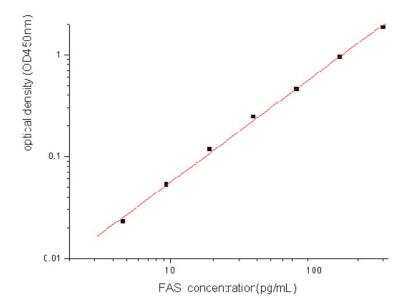Fas/TNFRSF6/CD95 Antibody Pair [HRP]
Novus Biologicals, part of Bio-Techne | Catalog # NBP2-79526

Key Product Details
Assay Type
Sandwich ELISA
Assay Range
4.69-300 pg/ml (example only; lot dependent)
Sensitivity
4.7 pg/ml (example only; lot dependent)
Reactivity
Human
Product Specifications
Description
Solid Phase sandwich ELISA for the quantitative determination of Human Fas/TNFRSF6/CD95.
Sample Volume Required
100 ul
Conjugate
HRP
Scientific Data Images for Fas/TNFRSF6/CD95 Antibody Pair [HRP]
Sandwich ELISA: Fas Receptor/TNFRSF6/CD95 Antibody Pair [HRP] [NBP2-79526] - This standard curve is only for demonstration purposes. A standard curve should be generated for each assay.
Kit Contents for Fas/TNFRSF6/CD95 Antibody Pair [HRP]
- Mouse Monoclonal Capture Antibody
- Mouse Monoclonal Detection Antibody (HRP-conjugated)
- Standard
Preparation and Storage
Shipping
The product is shipped with polar packs. Upon receipt, store it immediately at the temperature recommended below.
Stability & Storage
Storage of components varies. See protocol for specific instructions.
Background: Fas/TNFRSF6/CD95
Fas-FasL-mediated apoptosis is important in immune homeostasis and removal of autoreactive T cells, autoreactive B cells, cytotoxic natural killer (NK) cells, and more (1,2,7). Dysfunction and mutations in the Fas receptor and the Fas-FasL signaling axis is associated a loss of apoptotic signaling and removal of autoreactive cells, which correlates with several autoimmune diseases including systemic lupus erythematosus (SLE), autoimmune lymphoproliferative syndrome (ALPS), and multiple sclerosis (MS) (1-4,6,7). In addition to apoptosis and cell death signaling, FasL/TNFRSF6/CD95 mediates other pathways involved in proliferation, survival, and differentiation (3,4,6,8). More specifically, Fas has been shown to activate the NF-kappaB pathway, driving innate immunity which includes IL-1beta production and functioning in host defense (3,4,6,8). Fas is also involved in adaptive immunity playing a role in co-stimulation of CD4+ and CD8+ T cell activation as well as precocious differentiation of naive cells to effector memory T cells (3,4,6). Differentiation into effector memory T cells shows protection against autoimmunity but also limits antitumor response to a form of cancer immunotherapy called adoptive cell transfer (ACT) (3,4). The non-apoptotic roles of the Fas/TNFRSF6/CD95 receptor highlight its potential as a target for both treating autoimmune diseases and in cancer immunotherapy (3,4).
References
1. Singh R, Pradhan V, Patwardhan M, Ghosh K. APO-1/Fas gene: Structural and functional characteristics in systemic lupus erythematosus and other autoimmune diseases. Indian J Hum Genet. 2009;15(3):98-102. https://doi.org/10.4103/0971-6866.60184
2. Magerus A, Bercher-Brayer C, Rieux-Laucat F. The genetic landscape of the FAS pathway deficiencies. Biomed J. 2021;44(4):388-399. https://doi.org/1010.1016/j.bj.2021.06.005
3. Guegan JP, Legembre P. Nonapoptotic functions of Fas/CD95 in the immune response. FEBS J. 2018;285(5):809-827. https://doi.org/10.1111/febs.14292
4. Yi F, Frazzette N, Cruz AC, Klebanoff CA, Siegel RM. Beyond Cell Death: New Functions for TNF Family Cytokines in Autoimmunity and Tumor Immunotherapy. Trends Mol Med. 2018;24(7):642-653. https://doi.org/10.1016/j.molmed.2018.05.004
5. Uniprot (P25445)
6. Guegan JP, Ginestier C, Charafe-Jauffret E, et al. CD95/Fas and metastatic disease: What does not kill you makes you stronger. Semin Cancer Biol. 2020;60:121-131. https://doi.org/10.1016/j.semcancer.2019.06.004
7. Volpe E, Sambucci M, Battistini L, Borsellino G. Fas-Fas Ligand: Checkpoint of T Cell Functions in Multiple Sclerosis. Front Immunol. 2016;7:382. Published 2016 Sep 27. https://doi.org/10.3389/fimmu.2016.00382
8. Cullen SP, Martin SJ. Fas and TRAIL 'death receptors' as initiators of inflammation: Implications for cancer. Semin Cell Dev Biol. 2015;39:26-34. https://doi.org/10.1016/j.semcdb.2015.01.012
Long Name
Fibroblast-associated
Alternate Names
Apo-1, APT1, CD95, TNFRSF6
Gene Symbol
FAS
Additional Fas/TNFRSF6/CD95 Products
Product Documents for Fas/TNFRSF6/CD95 Antibody Pair [HRP]
Product Specific Notices for Fas/TNFRSF6/CD95 Antibody Pair [HRP]
This product is for research use only and is not approved for use in humans or in clinical diagnosis. Antibody Pairs are guaranteed for 6 months from date of receipt.
